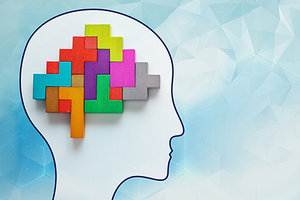Anxiety is a perfectly normal reaction to stress. It's a physical and psychological coping device, heightening responses and preparing the body for flight, fight or freeze. It helps us cope, uncomfortable as it might be. However, when anxiety morphs into an excessive and irrational dread of everyday situations – the things all people must cope with as the cost of everyday life – it can become a crippling psychological disorder.
In the West, though, anxiety is rife. An all-too-common manifestation of anxiety disorders discussed in the Western medical and psychological literature is obsessive-compulsive disorder.
OCD: Prevalence and Key Characteristics
 OCD is marked by recurrent, unwanted, and/or intrusive thoughts (obsessions), and/or repetitive motions and behaviors (compulsions), and affects as much as 2 percent of the population.2 Among 330 million Americans, that's a lot of people with OCD. For teens, about twice as many boys than girls are afflicted by OCD, although in adulthood the numbers even out.
OCD is marked by recurrent, unwanted, and/or intrusive thoughts (obsessions), and/or repetitive motions and behaviors (compulsions), and affects as much as 2 percent of the population.2 Among 330 million Americans, that's a lot of people with OCD. For teens, about twice as many boys than girls are afflicted by OCD, although in adulthood the numbers even out.
OCD is debilitating and particularly makes social life difficult. The result is that many people with OCD will self-isolate. Considering the roots of OCD – anxiety in everyday life – it is no surprise that impairments are across the board, including work, family, social relationships and recreation.
Would that the neuropsychiatrists had a better handle on OCD's pathogenesis, but the disorder continues to be a multifactorial mystery, generally imagined to be the result of complex interactions of biology, sociology and psychology. The idea of multifactorial disorders with diverse manifestations is common in TCM, and current thinking is that more than one organ-system imbalance needs correction. For example, spleen imbalance may be marked by recurrent intrusive thoughts, while kidney imbalance can manifest as fear that sparks compulsive or ritualized behavior, such as repetitive hand-washing.
Western vs. TCM Management of OCD
Western medicine has some pharmacological and therapeutic responses to OCD, but treatment response is uneven (40-60 percent success), can take a long time, has significant side effects, and is prone to relapse. About a third of all OCD patients do not have satisfactory responses to treatment – either they are treatment resistant or relapse and then become treatment resistant. In the Western medical system, their prognosis is poor. They will not die from OCD, but their lives will be severely limited. Clearly, it would be helpful to have alternative strategies and tactics to deploy.
Acupuncture is emerging as one of those alternative strategies and tactics, and is being noticed as such by clinical psychologists and psychiatrists. The impetus was the demonstration of acupuncture as effective in treating many instances of chronic pain. There has been an additional embrace by some practitioners of acupuncture to address post-traumatic stress disorder, generalized anxiety disorder, hospitalization stress, and other psychological issues. Many hospitals now make acupuncture part of their complementary medicine packages available to patients.
There is also new exploration of acupuncture variants, such as electroacupuncture and moxibustion, as methodologies in TCM to invigorate the brain and open the mind to the establishment of new neural pathways that can allay patient suffering.
Acupoints for OCD
These are the most common acupoints used by TCM practitioners to address OCD:
- Baihui (DU 20)
- Yintang (EX-HN 3)
- Taiyang (EX-HN 5)
- Neiguan (PC 6)
- Sanyinjiao (SP 6)
- Jiaji (EX-B 2)
There is clinical evidence that acupuncture at Baihui (DU 20) and Yintang (EX-HN 3) is effective with laboratory animals in changing OCD behavior, perhaps by re-regulating 5-HT activity and DA content.3 Other investigations follow the lead of TCM theory about the heart and bladder, and indicate that DU 20, Yintang, the SJ 5 (Waiguan) point, and the GB 41 (Zulinqi) point could be helpful for balancing the blood supply to the brain, doing the same for the hypothalamus-pituitary-epinephrine axis, settling norepinephrine metabolism, and regulating the releases of the spleen bi-directionally.4
There have also been studies reported in Chinese journals that show a benefit for OCD patients treated with electroacupuncture (EA), though these investigations lack the typical rigor demanded by Western peer review. In one of these, 19 patients suffering from OCD and resistant to treatment were assigned either to 12 sessions of EA over two-and-a-half weeks, or to a control waitlist in which they took their regular medication.
In the treatment group, the investigators used six paired acupoints: Baihui (Du 20) and Yintang (EX-HN 3); left, Sishencong (EX-HN 1) and Toulinqi (GB 15), right; Sishencong (EX- HN 1) and Toulinqi (GB 15); bilateral, Shuaigu (GB 8); bilateral, Taiyang (EX-HN 5); and bilateral, Touwei (ST 8). They found that continuous wave stimulation with electricity at nine volumes and two Hz helped to control OCD symptoms, and called for further investigation.5
With these promising results, and the finding of Tian3 that electroacupuncture and acupuncture are a helpful complement to Western-style treatment, TCM practitioners should strongly consider the use of these modalities to alleviate the terrible distress with which their OCD patients may present.
References
- Maciocia G. The Psyche in Chinese Medicine: Treatment of Emotional and Mental Disharmonies with Acupuncture and Chinese Herbs. Churchill Livingstone, 2009.
- Diagnostic and Statistical Manual of Mental Disorders: DSM-5. American Psychiatric Association, 2017.
- Tian C, et al. The efficacy and safety of acupuncture and moxibustion combined with Western medicine for obsessive-compulsive disorder: a protocol for systematic review and meta-analysis. Medicine, 2020 Aug 28;99(35):e21395.
- Lin N, et al. ";The Mechanism of Acupuncture for Obsessive-Compulsive Disorder on TCM Heart-Gallbladder Concept." 2012 IEEE International Conference on Bioinformatics and Biomedicine Workshops.
- Zhang Z-J, et al. Electroacupuncture for refractory obsessive-compulsive disorder. J Nervous Mental Dis, 2009;197(8):619-622.
Click here for more information about Nadiya Melnyk, DAOM, LAc.




